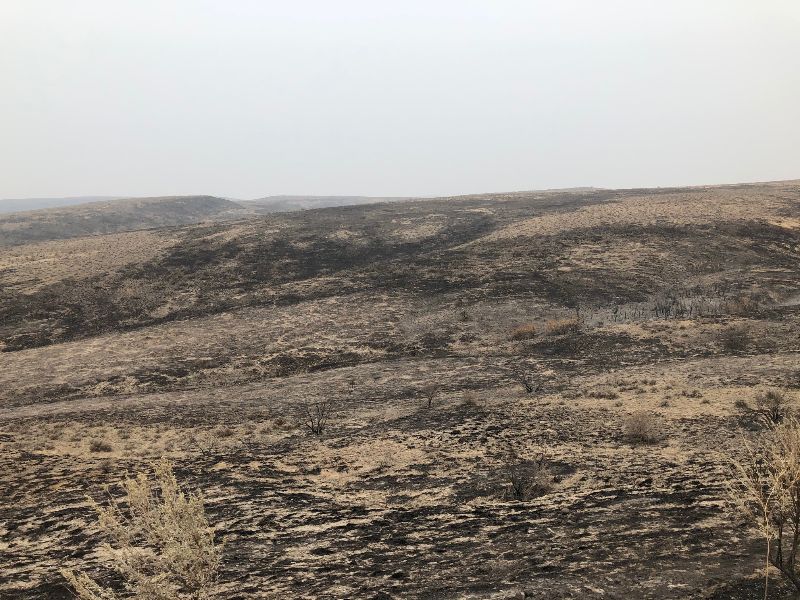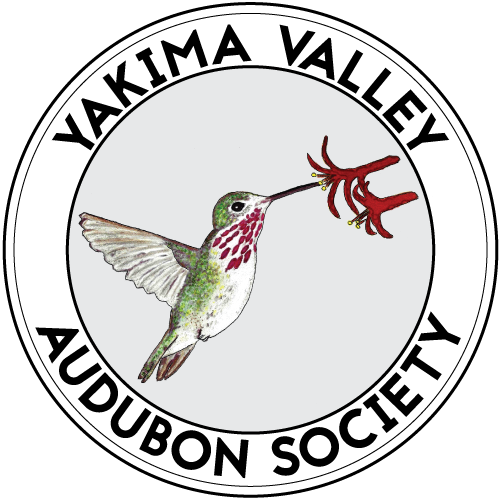Evans Canyon Fire Impacts and How You Can Help with Restoration
General ·On the afternoon of August 31, 2020, a fire broke out near the northern slope of Cleman Mountain in the Wenas Valley. Named the Evans Canyon fire, it would ultimately burn 75, 817 acres. The fire burned in two directions, heading down the Wenas Creek Valley but also burning northeast and burning in the Umptanum Creek watershed. Ultimately, the fire would burn to the edge of the Yakima River in the Umptanum watershed before it was finally controlled. In addition to the unfortunate loss of some structures and many people having to evacuate their homes and farms, the fire burned many acres of riparian and shrubsteppe (sagebrush) habitat.

The riparian habitats of Wenas and Umptanum Creeks contain highly diverse bird species, including some riparian specialists such as Yellow-breasted Chats, Gray Catbirds, and Veeries that are typically only found in localized high-quality riparian habitats. Not all the riparian habitat of these two creeks were burned, but riparian areas within the fire perimeter did burn, some at moderate intensity and some high intensity. For moderate intensity areas, there is hope. While it will take several years for the shrubs to recover to their habitat quality before the fire and it will take several decades for the riparian trees that died, such as Aspen and Cottonwood to become mature, signs of life were emerging within a month of the fire. In high intensity riparian areas, however, the fire did burn hot enough that natural regeneration is not likely within the next few years and will likely need some assistance to help with recovery.
The shrubsteppe habitat, particularly shrubs such as Big Sagebrush will fare much worse. Shrubsteppe is a declining habitat in Washington State, listed as imperiled by the Washington Department of Natural Resources Natural Heritage Program. Fires are a leading cause of this decline, with more than 10 fires greater than 50,000 acres occurring in the shrubsteppe of Washington State within the last decade. In the Evans Canyon fire perimeters, there were areas of quality sagebrush habitat before the fire. While some of the bunchgrass and forbs (wildflowers) may quickly resprout if the fire did not burn their roots or crowns, the shrubs such as sagebrush will be lost because sagebrush does not resprout from its roots. In such an extensive burn, there will be no nearby sources of sagebrush for natural reseeding to occur. Without assistance, these areas are likely to take several decades to restore to shrubsteppe habitat. Replanting these areas, particularly with sagebrush seeds or plugs (young sagebrush plants) and bunchgrass seed mixture will help to restore these habitats and could hasten the process by up to a decade if replanting is successful.
Looking at the effects from such a large fire and the impacts to the birds and wildlife we all cherish can be difficult. Many of our members may be asking, what can we do to help restore habitats? Listed here are several ideas worth considering.
- If you are a landowner within the fire and would like technical assistance to restore riparian or shrubsteppe habitats on your land, North Yakima Conservation District is a great resource and can provide technical assistance and possibly financial assistance. https://northyakimacd.wordpress.com/
- If you would like to provide volunteer assistance to help restore either riparian or shrubsteppe habitats on the Washington Department of Fish and Wildlife Wenas Wildlife Area, you can contact me at downess@charter.net and I would be happy to put you in contact with the Wildlife Area Manager. The opportunities to help include reseeding shrubsteppe areas this fall and replanting riparian areas this winter. If you are interested in monitoring the restoration efforts, volunteers are needed to help monitor survival of both shrubsteppe and riparian area restoration efforts as plants sprout in the spring of 2021. Finally, volunteers can also help repair wildlife area fence that was damaged by the fire and the wildlife area can also use eyes to help monitor post-fire effects and report if they are noticing erosion damage or new concentrations of weeds following the fire.
- Finally, you can help to prevent future fires. An article written by Washington State Department of Natural Resources outlines simple steps you can take while being in the outdoors to lessen the risk that you will contribute to starting a wildfire: https://washingtondnr.wordpress.com/2016/03/22/preventing-human-caused-wildfires/
With our help, these areas may have the ability to restore to functional habitats for the many shrubsteppe and riparian area birds that we all enjoy.
-Scott Downes
